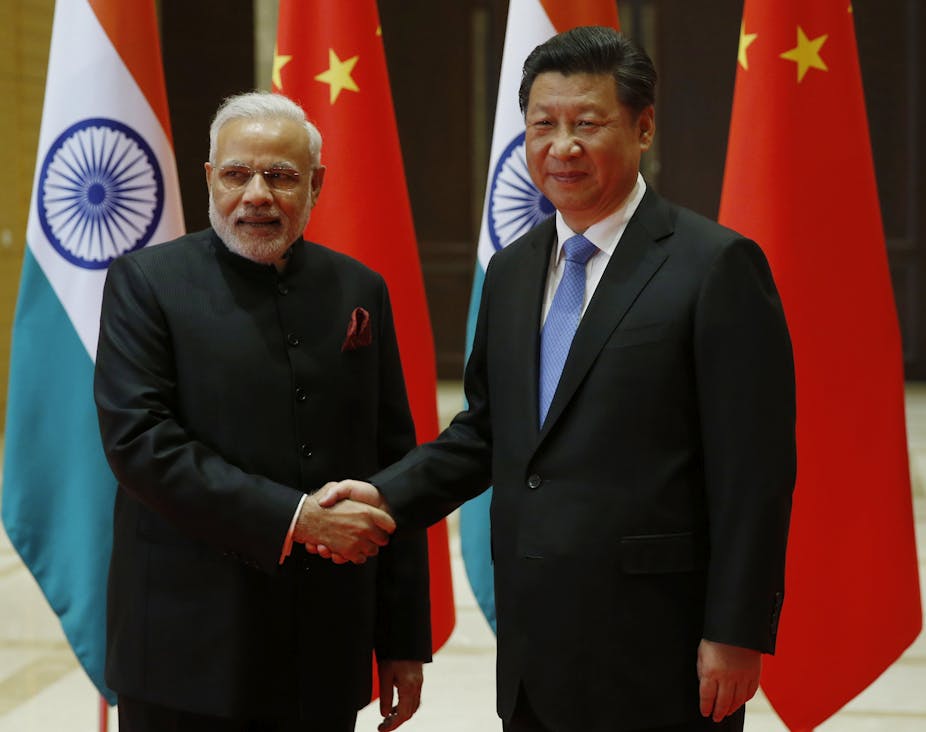India and China have signed US$22 billion worth of business deals. Indian prime minister Narendra Modi’s three-day visit to the neighbouring economic powerhouse was meant to mark a new chapter in relations between the world’s two most populous countries. Modi was certainly received warmly, but the symbolism on display betrayed the complexity of the two countries’ rivalry.
Take Modi’s first destination, Xian. It was chosen partly to reciprocate the reception that Chinese president, Xi Jinping received in Modi’s home state of Gujarat in 2014. Modi was given an elaborate reception with actors in full Tang Dynasty costume. He was also taken to see the Terracota Warriors and a Buddhist temple. But what could be seen as gestures of friendship may also be interpreted as China asserting its historical and cultural grandeur, as well its Buddhist credentials in the context of an emerging soft power rivalry.
In terms of discussion, contentious issues were put to one side. The border dispute that dates back to 1914 and was the source of a brief but bitter war between the two countries in 1962 was brushed over – both sides agreed to seek a “fair resolution”. Meanwhile, a concerted effort was made to display a budding friendship between the two countries, including the selfie posted by Modi with Premier Li in Beijing:
Huge potential
The need to boost both their economies is something both countries can readily agree on. The potential for mutual benefit is huge, but it has yet to be realised. There are also growing inequities and asymmetries that require ironing out at the highest levels.
Modi won his landslide electoral victory on the promise of rejuvenating India’s economy for which he needs access to China’s market and investment. China too is faced with a slowing economy. In light of sluggish domestic demand and depressed Western markets, India is a significant alternative. China also needs Indian cooperation for the success of its “Silk Road” projects to open up trade with Europe, the Middle East and Africa through land and maritime routes.
Although trade between the two rising powers has been growing, the goal set in 2010 of taking the volume of bilateral trade to US$100 billion by 2015 has yet to be realised. In 2014, bilateral trade was only US$71 billion – considerably less than the trade between China and much smaller economies like South Korea (US$290.49 billion) and Taiwan (US$198.31 billion). To this effect, trade deals covering education, railway infrastructure, renewable energy, ports, financing, telecommunications and film were signed.
Unbalanced relationship
Growing trade is taking place in a context of multiple economic asymmetries in China’s favour. China’s economy of US$9.2 trillion was almost five times larger than India’s US$1.9 trillion in 2013. And while China is India’s biggest trade partner, India is outside China’s top ten partners. Also, India suffered a trade deficit of US$38 billion in 2014 and signs are that this imbalance will only widen.
Some of these imbalances could be set to even out, however. Even though India’s economy is smaller, it is slated to grow faster than China from 2016. According to International Monetary Fund forecasts, India will grow at a rate of 6.5% compared to China’s 6.3%. And India’s finance minister has claimed India is on track to overtake Chinese growth with annual expansion of more than 8%.
These growth figures and the demographic advantage that India will enjoy well into the middle of the 21st century, explain why China is taking India more seriously than it had in the past. The same goes for the lengths that Beijing is going in courting New Delhi.
There are of course other reasons why China wants closer relations with India. In its competition with the US, China wants India on its side to at least forestall its participation in any form of anti-China balancing coalition. This is pressing because India’s relations with the US, Japan, Vietnam and Australia are growing stronger by the year, unmistakably because of their common concern about China’s growing assertiveness.
So even on the economic front, there is competition to be had. And though the number of agreements signed show how trade deals can soften their rivalry, divisive political and security issues remain – including the border dispute, Tibet and the Dalai Lama, as well as China’s support of Pakistan and Kashmir. So long as these issues remain unresolved, mistrust and mutual perception of threat will persist.

